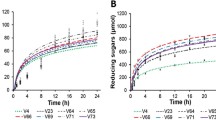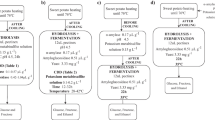Abstract
The amylose/amylopectin ratio in cereal substrates is one of the parameters affecting starch hydrolysis and fermentation process. Waxy (less than 1 mass % of amylose) starch seems to be suitable for improving the fuel ethanol production. The main aim of this paper was to characterize the fermentation performance of corn and wheat waxy and non-waxy cultivars in terms of simultaneous saccharification and fermentation (SSF) as well as of the separated hydrolysis and fermentation (SHF) type. Two corn (waxy and non-waxy) and two wheat (waxy and non-waxy) cultivars were used for the comparison applying separate enzymatic hydrolysis and fermentation. In the SHF process, the glucose content was higher after saccharification in the waxy corn and wheat compared to that in non-waxy corn and wheat. In the SSF of waxy varieties, the glucose content after the pre-saccharification was also higher than in the non-waxy ones. Although the starch content did not vary significantly, differences in the glucose content after saccharification were observed. The ethanol yield obtained after the distillation of mash varied from 229.2–262.3 L per ton for the SHF fermentation, while it was in the range of 311.5–347.9 L per ton for the SSF process.
Similar content being viewed by others
References
AACC International (2012). AACC 32-05.01 Total dietary fiber. In Approved methods of analysis (11th ed.). St. Paul, MN, USA: AACC International.
AOAC International (1990). AOAC 985.29. Total dietary fiber in foods. Enzymatic — gravimetric method. In Official methods of analysis of the Association of Official Analytical Chemists (15th ed.). Arlington, VA, USA: AOAC International.
Chandel, A. K., Chan, E. S., Rudravaram, R., Narasu, M. L., Rao, L. V.,& Ravindra, P. (2007). Economics and environmental impact of bioethanol production technologies: an appraisal. Biotechnology and Molecular Biology Reviews, 2, 14–32.
Choi, S. G.,& Kerr, W. L. (2004). Swelling characteristics of native and chemically modified wheat starches as a function of heating temperature and time. Starch — Stärke, 56, 181–189. DOI: 10.1002/star.200300233.
Chromý, V., Breinek, P.,& Roháček, J. (1987). Some factors influencing the enzymatic determination of glucose on the basis of oxidative copulation. Biochemia Clinica Bohemoslovaca, 16, 275–283. (in Czech)
Dien, B. S., Bothast, R. J., Iten, L. B., Barrios, L.,& Eckhof, S. R. (2002). Fate of Bt protein and influence of corn hybrid on ethanol production. Cereal Chemistry, 79, 582–585. DOI: 10.1094/cchem.2002.79.4.582.
Dorta, C., Oliva-Neto, P., de-Abreu-Neto, M. S., Nicolau-Junior, N.,& Nagashima, A. I. (2006). Synergism among lactic acid, sulfite, pH and ethanol in alcoholic fermentation of Saccharomyces cerevisiae (PE-2 and M-26). World Journal of Microbiology and Biotechnology, 22, 177–182. DOI: 10.1007/s11274-005-9016-1.
Fannon, J. E., Hauber, R. J.,& BeMiller, J. N. (1992). Surface pores of starch granules. Cereal Chemistry, 69, 284–288.
Fortuna, T., Juszczak, L., Kujawski, M.,& Pałasiński, M. (2000). Porosity of starch granules and their susceptibility to the action of bacterial α-amylase. Zeszyty Naukowe Akademii Rolniczej, 367, 51–64. (in Polish)
ISO (1997). ISO standard. Native starch — Determination of starch content — Ewers polarimetric method. ISO 10520:1997. Geneva, Switzerland.
ISO (2006). ISO standard. Cereals and pulses — Determination of the nitrogen content and calculation of the crude protein content — Kjeldahl method. ISO 20483:2006. Geneva, Switzerland.
ISO (2007a). ISO standard. Rice — Determination of amylose content — Part 1: Reference method. ISO 6647-1:2007. Geneva, Switzerland.
ISO (2007b). ISO standard. Cereals, pulses and by-products — Determination of ash yield by incineration. ISO 2171:2007. Geneva, Switzerland.
Jane, J. L., Ao, Z., Duvick, S. A., Wiklund, M., Yoo, S. H., Wong, K. S.,& Gardner, C. (2003). Structures of amylopectin and starch granules: How are they synthesized? Journal of Applied Glycoscience, 50, 167–172. DOI: 10.5458/jag.50.167.
Jacques, K., Lyons, T., & Kelsall, D. (2003). Substrates for ethanol production. In K. Jacques, T. Lyons, & D. Kelsall (Eds.), The alcohol textbook (4th ed., pp. 41–84). Nottingham, UK, Nottingham University Press.
Latif, F.,& Rajoka, M. I. (2001). Production of ethanol and xylitol from corn cobs by yeasts. Bioresource Technology, 77, 57–63. DOI: 10.1016/s0960-8524(00)00134-6.
Manners, D. J. (1989). Recent developments in our understanding of amylopectin structure. Carbohydrate Polymers, 11, 87–112. DOI: 10.1016/0144-8617 (89)90018-0.
Miller, G. L. (1959). Use of dinitrosalicylic acid reagent for determination of reducing sugar. Analytical Chemistry, 31, 426–428. DOI: 10.1021/ac60147a030.
Moorthy, S. N. (2002). Physicochemical and functional properties of tropical tuber starches: A review. Starch — Stärke, 54, 559–592. DOI: 10.1002/1521-379X(200212)54:12〈559::AIDSTAR 2222559〉3.0.CO;2-F.
Nakamura, T., Yamamori, M., Hirano, H., Hidaka, S.,& Nagamine, T. (1995). Production of waxy (amylose-free) wheats. Molecular and General Genetics, 248, 253–259. DOI: 10.1007/bf02191591.
O’Connor-Cox, E. S. C., Paik, J.,& Ingledew, W. M. (1991). Improved ethanol yields through supplementation with excess assimilable nitrogen. Journal of Industrial Microbiology and Biotechnology, 8, 45–52. DOI: 10.1007/bf01575590.
Ophardt, C. E. (2003). Virtual chembook. Elmhurst, IL, USA: Department of Chemistry, Elmhurst College. Retrieved April 28, 2012, from http://www.elmhurst.edu/~chm/vchembook/547starch.html
Reicks, G., Woodward, H. J.,& Bly, A. (2009). Improving the fermentation characteristics of corn through agronomic and processing practices. Agronomy Journal, 101, 201–206. DOI: 10.2134/agronj2007.0398.
Robyt, J. F. (2001). Polysaccharides: Energy storage. In Encyclopedia of Life Sciences. New York, NY, USA: Wiley. Retrieved March 12, 2012, from http://jdc325.files.wordpress.com/2008/08/polysaccharides-and-energystorage.pdf. DOI: 10.1038/npg.els.0000700.
Roháček, J., Chromý, V.,& Kolářová, J. (1987). Kinetic glucose determination with’ Bio-La-Test Oxochrom GLUKOSA’ testkit. Biochemia Clinica Bohemoslovaca, 16, 183–188. (in Czech)
Sharma, V., Rausch, K. D., Tumbleson, M. E.,& Singh, V. (2007). Comparison between granular starch hydrolyzing enzyme and conventional enzymes for ethanol production from maize starch with different amylose: amylopectin ratios. Starch — Stärke, 59, 549–556. DOI: 10.1002/star.200700631.
Thomas, D. J., & Atwell, W. A. (1999). Starches handbook. St. Paul, MN, USA, American Association of Cereal Chemists.
Thomas, K. C.,& Ingledew, W. M. (1990). Fuel alcohol production: Effects of free amino nitrogen on fermentation of very-high-gravity wheat mashes. Applied and Environmental Microbiology, 56, 2046–2050.
Tichý, F. (2001). The growth technology and treatment of wheat and triticale grain for the ethanol production (IAFI Agricultural information, 5/2001). Prague, Czech Republic: Institute of Agricultural and Food Information. (in Czech)
van der Marel, M. J. E. C, van der Veen, B., Uitdehaag, J. C.M., Leemhuis, H., & Dijkhuizen, L. (2002). Properties and applications of starch-converting enzymes of the α-amylase family. Journal of Biotechnology, 94, 137–155. DOI: 10.1016/s0168-1656(01)00407-2.
Wu, X., Zhao, R., Wang, D., Bean, S. R., Seib, P. A., Tuinstra, M. R., Campbell, M.,& O’Brien, A. (2006a). Effects of amylose, corn protein, and corn fiber contents on production of ethanol from starch-rich media. Cereal Chemistry, 83, 569–575. DOI: 10.1094/cc-83-0569.
Wu, X., Wang, D., Bean, S. R., & Wilson, J. P. (2006b). Ethanol production from Pearl Millet by using Saccharomyces cerevisiae. Cereal Chemistry, 83, 127–131. DOI: 10.1094/cc-83-0127.
Zhao, R., Wu, X., Seabourn, B. W., Bean, S. R., Guan, L., Shi, Y. C., Wilson, J. D., Madl, R.,& Wang, D. (2009). Comparison of waxy vs. nonwaxy wheats in fuel ethanol fermentation. Cereal Chemistry, 86, 145–156. DOI: 10.1094/cchem-86-2-0145.
Author information
Authors and Affiliations
Corresponding author
Rights and permissions
About this article
Cite this article
Gago, F., Horváthová, V., Ondáš, V. et al. Assessment of waxy and non-waxy corn and wheat cultivars as starch substrates for ethanol fermentation. Chem. Pap. 68, 300–307 (2014). https://doi.org/10.2478/s11696-013-0454-1
Received:
Revised:
Accepted:
Published:
Issue Date:
DOI: https://doi.org/10.2478/s11696-013-0454-1




